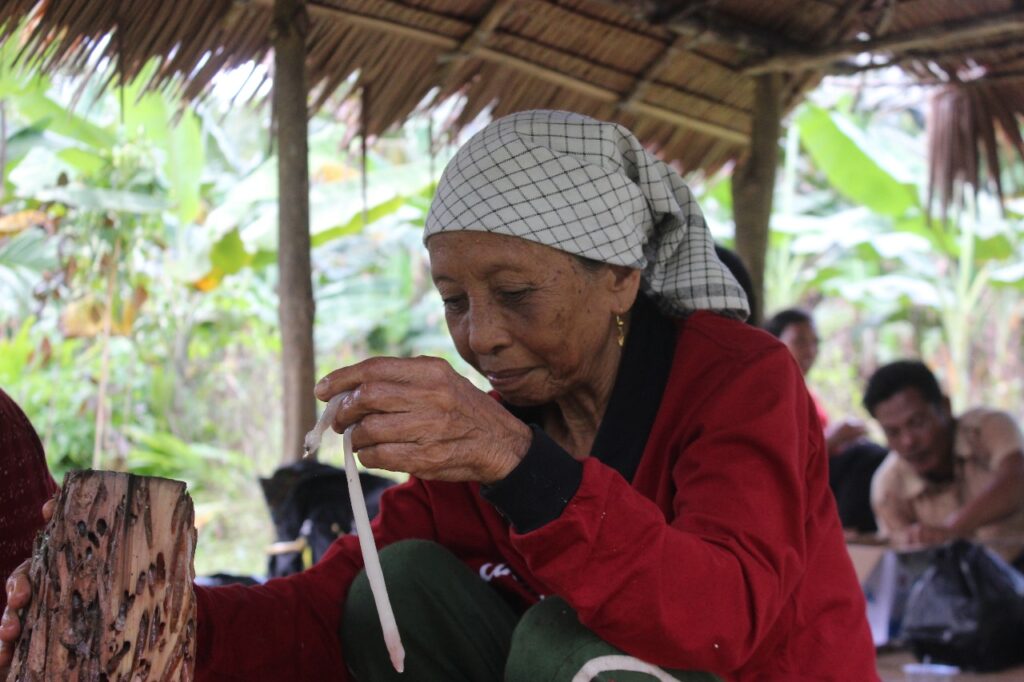The Mentawai Islands are famous for their natural and cultural attractions that attract tourists, both local and foreign. Apart from the tourism and cultural sectors, the Mentawai Islands also have interesting culinary stories. One of them is Toek, a type of woodworm that comes from Kayu Tumung, Kayu Bak-Bak, and Kayu Etet. In addition to Toek, there is also Batra or Ulat Sago which is obtained from sago trees. In addition to containing high protein, Toek also has a high economic value where one Kayu Tumung trunk with a larger diameter of wood, will have a greater selling value.
"The price ranges from 50 thousand per stem with a length of +70 cm, some even reach 200 thousand, so that one whole Tumung tree can reach 1 million," said Lia Anjelina, one of the village officials of Kaur Umum in Nemnemleleu Village.
Before it can be eaten, the wood that produces Toek must be soaked first. From the results of this soaking, the wood will produce Toek or Wood Worms. The process of soaking the wood takes quite a long time, which is approximately 3 months. To produce Toek, of course, the Mentawai indigenous people use selected wood so that the process can be faster and the results are also good. The wood is usually divided into several parts with predetermined sizes.
"Usually about half a meter. Then, people will soak the wood in the river and tie it with rope so it doesn't float away," said Lia.
After 3 months, the soaked wood is lifted and split with an axe. Inside the rotten Tumung Wood is Toek. Usually after the soaking period, the women will gather at the river. Astrid Nadila Putri or called Dila (19) said that Mutoek is not just about eating together but also exchanging information. Mutoek is a term used by the women in the Mentawai indigenous community when they eat Toek together.
"They say it has a high protein content, it tastes like milk, it has a savory taste, eating Toek together for us is not just about eating, but we also usually exchange information about other residents, about households, about fields, children. Maybe outsiders call it gossip, so with this Mutoek we can exchange information with other women, and even learn from each other," added Dila while eating Toek.
The process of making Toek also depends heavily on the condition of the river water when it is soaked. If it is the dry season, Toek will not contain anything because the water content tends to be low. However, during the rainy season, the quality of Toek is not so good because the water quality is not clean. After being soaked for 3 months or even up to 4 months, the wood is split using an axe, and the worms called Toek will gather in it during the rotting process in the wood.
Toek is similar to earthworms, its color tends to be pale white with a reddish tinge. Mentawai people usually eat Toek raw, it tastes savory. But there are also those who add lime juice, salt, and sliced raw shallots and cayenne pepper.
In the process of making Toek, there are several areas that apply rules in the Mentawai traditional community, such as women who are menstruating are prohibited from being involved in the manufacturing process. In addition to supporting local food commodities, Toek is also a symbol of togetherness, solidarity, and harmony among the community. The division of roles between men and women is also apparent in the process of making Toek. Lia Anjelina (31) said that Toek shows cooperation between women and men. Men are usually tasked with cutting wood as a material for making Toek until the process of soaking it in the river.
"Women will be on duty after the soaking process is complete. Usually we will go to the river and split the wood that has been filled with Toek," added Lia.
Mentawai Independent Image Foundation (YCMM) held a discussion on local food practices in Nemnemleleu Village involving indigenous women's groups from 3 hamlets, namely Central, North and South Nemnemleleu Hamlets. In this discussion, Toek became one of the topics mentioned as one of the local foods of the Mentawai Islands which has good levels of protein and fat for the body. Of course, besides fish which is the main commodity in the region which is mostly an archipelago.
For the Mentawai Tribe, Toek has become a daily snack and a symbol of solidarity among residents, especially women and young girls. When they gather, it usually becomes lively when chatting while eating Toek.
In this series of activities, participants not only discussed but were also invited to process several commodities such as taro, bananas into cookies and bread. This activity aims to encourage communities, especially women's groups, to be able to develop the potential of their areas in supporting family nutrition and economy.
"Usually the processed products of this group are marketed for punen or traditional parties around the village only and several times are ordered by Village Officials for meeting activities in the village," said one of the discussion participants.
"I hope that by getting to know more about local diversity and potential, food commodities in the Mentawai Islands will be more sovereign. So that it reduces dependence on instant foods," said Mina as Treasurer of the SL (Field School) OMB Silasi group during the discussion.


